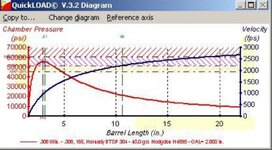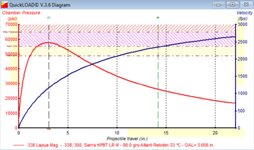Loading up my 308 w/16" barrel. I am trying to get 100 percent burn rate. I have Benchmark, 4198, 3031. I have tried each and they all shoot well at the low end. The question... is burn rate the deciding factor? All run a different load weight. So why not run the fastest? I am using the Hodgdon pistol load charts.
Navigation
Install the app
How to install the app on iOS
Follow along with the video below to see how to install our site as a web app on your home screen.
Note: This feature may not be available in some browsers.
More options
Style variation
You are using an out of date browser. It may not display this or other websites correctly.
You should upgrade or use an alternative browser.
You should upgrade or use an alternative browser.
Help me under stand burn rate.....
- Thread starter tacks
- Start date
TaperPin
WKR
- Joined
- Jul 12, 2023
- Messages
- 5,375
At one time burn rate seemed to be what we primarily judged powders on, but those days are long gone. Max velocity is generated by maximizing the pressure curve for the entire travel of the bullet, rather than a complete burn.
Single base powders perform one way, double base powders perform a different way, and there are coatings applied to the surface of either that further alter the pressure curve.
Single base powders perform one way, double base powders perform a different way, and there are coatings applied to the surface of either that further alter the pressure curve.
TaperPin
WKR
- Joined
- Jul 12, 2023
- Messages
- 5,375
Pressure curves are interesting. Programs like quickload will estimate the pressure curve for a given load. These aren’t my screen grabs, or even the same cartridge, but show a faster and slower powder and what pressure and velocity are doing at different barrel lengths. Double base powders try to get a fast initial peak combined with a longer burn at higher pressure so the curve is more drawn out.




A382DWDZQ
WKR
- Joined
- Dec 3, 2021
- Messages
- 810
Burn rate typically refers to the speed the powder burns at. The percentage of powder burned, not sure what it’s called, maybe Burn Percent or “%Burned” or efficiency is a different measure.
For efficiency, I try to stay pretty close to 100% when looking for a powder to start with, but i have loads that are definitely down in the 80%s. I don’t know that it affects accuracy much for my hunting tolerances.
For efficiency, I try to stay pretty close to 100% when looking for a powder to start with, but i have loads that are definitely down in the 80%s. I don’t know that it affects accuracy much for my hunting tolerances.
Burn rate is really for determining which powders may work in a particular application. What you are trying to do is match the rate of gas expansion to the change in area inside the barrel as the bullet is moving. If it’s too slow, the pressure drops and it’s slow. Too fast and the gas volume increases too fast with the bullet not moving fast enough leading to a spike in pressure. Get it right and the pressure stays in a safe window accelerating the bullet all the way down the barrel. You may notice that as the bore gets smaller, you need slower powders for the same case capacity. It’s because the area doesn’t change as fast due to the smaller bore. So what may work in a 243 maybe to slow for a 358 win.Loading up my 308 w/16" barrel. I am trying to get 100 percent burn rate. I have Benchmark, 4198, 3031. I have tried each and they all shoot well at the low end. The question... is burn rate the deciding factor? All run a different load weight. So why not run the fastest? I am using the Hodgdon pistol load charts.
Some powders have more area under the pressure curve than others and those will have more velocity even though the burn rate may be similar. This is controlled by the chemistry, shape of the powder, and additives. In your case of running a short barrel, using a faster powder (for 308) and lighter bullet will probably work the best. A slow powder will result in more unburned powder, but I would not try to get 100% burn. I find a lot of loads don’t finish burning until after bullet exit unless running long barrels, ie 26-28”.
Ruggedsportsman
FNG
- Joined
- Aug 7, 2025
- Messages
- 11
Yes. Anything less than 100% burn rate will have inconsistent ignition which means higher SD/ES and could possibly open your groups. If you have a 94% burn rate and drop 20° temperature, on top of your load being naturally slower you will also drop down to say a 89% burn rate resulting in an even slower load. The one thing you can control in terms of temperature sensitivity is the burn rate. You’re heads in the right place by looking at Hodgdon pistol data. I literally just went through this in my 16” 308 a couple weeks ago. I don’t know what bullets you’re trying to run but N135 is the easy button for a 100% burn in a short barrel.
Similar threads
Featured Video
Latest Articles
- TT#62 Brian Barney Hunting Bulls without Calling
- Hoyt Alpha AX-2 SD Review
- Kuiu Kenai vs Outdoor Vitals Vario Hooded Jacket Review
- Hoyt RX-9 Ultra Review
- Hunting Vampire Bucks & Building an Optics Kit
- Darton Sequel ST2 35 Review
- TT#61 Gear and Skills for Success with Aron Snyder
- Vortex Viper Shotgun Enclosed Micro Red Dot Review
- Howard’s Total Vise Legacy Bow Press
- Tcams, Point Creep, Scouting, & The Hunt Source Podcast
